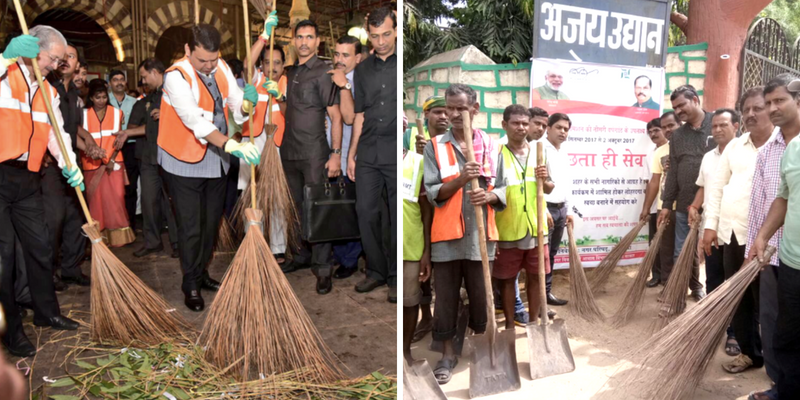Jharkhand, Indore, and Mumbai score big on the Swachh Bharat Abhiyan survey
The cities were assessed on the basis of the data submitted by the civic bodies on cleanliness and sanitation, as well as feedback from the citizens.

“A clean India would be the best tribute India could pay to Mahatma Gandhi on his 150th birth anniversary in 2019,” Prime Minister Narendra Modi’s words echoed across the country on October 2, 2014, as he launched the Swachh Bharat Abhiyan (SBA).
With an aim to achieve this vision and encourage cities to improve urban sanitation, Minister of Housing and Urban Affairs started the ‘Swachh Survekshan’ survey in 2016. Over the past three years, the survey has acted as a tool for motivation of large-scale citizen participation, and has created awareness amongst all sections of society about collective action towards making towns and cities cleaner.
Between January 4 and March 10 2018, the ministry conducted its first pan-India survey to assess cleanliness in urban India, and ranked 4,203 cities. While Indore retained its title for being India’s cleanest city, Bhopal ranked second and Chandigarh, third.
The cities were assessed on the basis of the data submitted by the civic bodies on cleanliness and sanitation, as well as feedback from the citizens. The assessment criteria included open defecation free (ODF) progress, collection and transportation of solid waste and processing of solid waste.
Swachh Survekshan 2018 awarded multiple cities and states based on broad population categories, sub-categories, including ‘the cleanest city’ or ‘the fastest moving city’, ‘cities with best solid waste management practices’, ‘highest citizen feedback’, ‘best innovation and practices followed’ etc.
Let’s take a look at the positive steps some of the cities have taken.
1. Indore- Cleanest City
The commercial capital of Madhya Pradesh defeated 433 cities to win its maiden ‘clean city’ tag in 2017. One of the primary reasons that helped Indore to retain its top position is because the city opted for a decentralised waste management system and showed “significant improvement” in segregating the waste at source.
With a tagline of ‘Swachhta aadat hai, swachhta utsav hai’, (Cleanliness is a habit, cleanliness is a celebration) the Indore Municipal Corporation cleanliness campaign claims to have achieved 100 percent segregation of wet and dry waste at source.
Municipal vehicles travel daily, once to households and twice to commercial areas, collecting garbage that is sent to the trenching ground via transportation hub.
With nearly 10,000 employees and officers to foster cleanliness as a habit, the Indore Municipal Corporation devised innovative bottle-shaped dustbins to encourage vehicle owners to not throw waste out the window. They distributed 1,000 such dustbins to car owners and, presently, they are sold at the market for Rs 35 each.
Another initiative included the employing of over 1,000 ragpickers who were positioned outside hotels, and marriage halls and would make compost from organic waste.
Further, Mayor Malini Gaud held over 400 meetings with citizens and residential welfare associations and administered the oath of cleanliness to over four lakh people, while Swachhata Samitis were set up in schools and colleges.
2. Jharkhand- Best Performing State
In a surprise move, Jharkhand emerged as the ‘Best Performing State’ in the Swachchhta Sarvekshan survey, followed by Maharashtra and Chhattisgarh. This feat is particularly commendable for the state seeing how it ranked lowest and scored poorly when the survey was first introduced in 2015. However, last year, Jharkhand jumped to third spot with increased and robust citizen movement spread across the state. These citizens regularly gave feedback to the municipal corporation based on their daily experience.
Residents started to purchase blue and green bags and started to segregate waste on their own. Citizens also initiated several events that highlighted the importance of cleanliness. For instance, during the festival of Makkar Sankranti this year, the Jamshedpur Notified Area Committee (JNAC), in collaboration with Japan United Stores Company (Jusco), organised a kite-flying festival to promote Swachh Bharat Abhiyan. It was attended by thousands of kids and youngsters.
The JNAC also distributed around 1,000 kites carrying waste segregation messages to generate awareness on cleanliness.
In 2015-16, 81,527 application of individual toilets were received against the target of 1,20,000, while 43,272 applications were sanctioned and processed. The Central government sanctioned 68 percent of the Rs 259.2 crore allotted for the SBM in Jharkhand last year. Several women self-help groups in villages played a crucial role to help reduce the open defection menace in the state.
In 2014, 80 percent of rural households had no access to toilets, with the toilet construction rate being a mere 10 percent between 2001 and 2011. However, in the past three years, the state’s sanitation coverage has improved to 59.13 percent. According to the state’s reports, over 15 lakh toilets have been built since the launch of the Swachh Bharat Abhiyan, with Ramgarh and Lohardaga becoming ODF districts.
With collaborative efforts, the state started to witness changes and the results are reflected on this year’s survey— capital Ranchi became the Best State Capital while Giridih won the ‘Best City’ in the three lakh population range. Further, Bundu, part of Ranchi district, along NH-33, became east zone's cleanest city to have a population below one lakh. Pakur became east zone's best city for innovation and best practices having a population of above one lakh, and Chaibasa topped east zone in solid waste management.
3. Mumbai- Cleanest State Capital
Mumbaikars have multiple reasons to cheer. The financial capital of India won several accolades in the Swachh Survekshan including ‘Cleanest State Capital’ while Navi Mumbai won for the best solid waste management among cities with a population of over 10 lakh.
Last year, Mumbai dropped in rankings to 29th place against the 10th position it held in the 2016 survey.
In 2017, Chief Minister Devendra Fadnavis launched several incentives, including a prize money of Rs 20 crore to the cities covered under the Atal Mission for Rejuvenation and Urban Transformation (AMRUT) scheme, in a bid to improve the state’s cleanliness index. He also announced a Swacch Ward, or clean ward competition where cleanliness and timely disposal of waste was awarded.
“Increase in the number toilets, door-to-door garbage collection in slums, closure of open garbage dumps, garbage segregation and treatment helped us grab the position this time. However, instead of looking at what we have achieved, we will now look forward to the challenges before us," Brihanmumbai Municipal Corporation Commissioner Ajoy Mehta told The Indian Express.
"Even though there was a quantum jump in number of toilets, we want to push for more toilets and renovation of old ones. We want to put an end to just dumping garbage in landfills and start scientific disposal and treatment of waste. All this is our target for next year,” he added.
While the clock is ticking on the target of achieving 100 percent Swachh Bharat by 2019, active steps by cities and State governments such as the above will help India become a cleaner country to live in.







![[Startup Bharat] Y Combinator-backed BeWell Digital is enabling the digital transformation of radiologists](https://images.yourstory.com/cs/2/40d66ae0f37111eb854989d40ab39087/ImagesFrames31-1648033042143.png)

